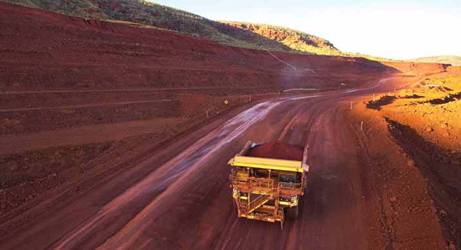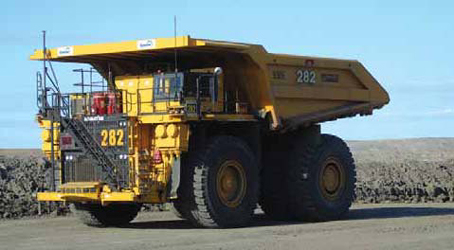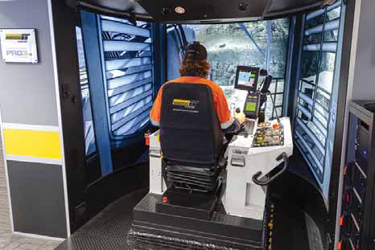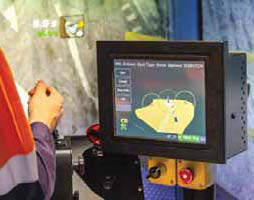
A hydraulic excavator loads an autonomous hauler at Suncor’s Steepbank oil sands mine in northern
Alberta, Canada. (Photo: Suncor)
Optimizing Autonomous Haulage
To get the most from an autonomous haul fleet, mines need to carefully consider every
aspect of system implementation and prepare their workforce for significant change.
E&MJ looks at some critical areas, and how one miner is getting great results.
By Carly Leonida, European Editor

The collision was reported just a month after one at Fortescue Metals Group’s (FMG) Christmas Creek mine in the Pilbara. In that case, a truck backed into another unit that was standing stationary thanks to an outage in the mine’s Wi-fisystem. In both cases, external factors were determined to be the cause rather than a failure in the autonomous system. While this was good news for other system users and, no doubt, a relief for the technology vendors, there are still two important lessons that can be taken away from these events.
First, that even the largest and most experienced fleets fitted with some of the best safety technology can still experience issues. FMG has been running an autonomous fleet at its Solomon Hub since 2012. The company had around 137 autonomous trucks in the Pilbara at last count and is expanding this to 175 by mid-2020 making it the owner of one of the world’s largest autonomous truck fleets alongside Rio Tinto. As of September, the FMG fleet has hauled more than 1 billion metric tons (mt) and has delivered a 30% productivity improvement for its owner. However, this success does not make it invincible.
It is inevitable that, as the uptake of AHSs increases and the demands placed upon them escalate, incidents will occur. So, it’s important that when they do, mine engineers learn all they can and use that information to prevent them from happening again.
Second is the understanding that the success of an AHS is based on much more than just the quality and capability of the technologies selected. There are thousands of factors that must be considered and allowed for when implementing a fleet, from the network that underpins mine communications to some, such as the weather, which are very much out of the mine operator’s control. Operators and their business partners must be prepared for a continuous journey of learning, adjustment and improvement.
Considering Autonomous
Haulage
Incidents such as those mentioned previously
shouldn’t deter or discourage
operators from considering autonomous
haulage. The knowledge of AHSs and experience
with them is constantly building
and, if the lessons garnered are properly
applied, then with each failure, the potential
success of future projects improves.
The technologies used are also advancing
quickly, and as systems become
more refined and accessible, and the benefits more tangible, more mines are evaluating
their use.
This is evident in the plethora of orders placed this year for both new autonomous trucks and retrofits; Rio Tinto purchased 20 autonomous 40-ton trucks for Koodaideri in May, and Ukrainian ironore producer, Ferrexpo, said in November it was converting 15 of its haul trucks to autonomous operation. So where should operators looking to join these ranks begin? Aidan Ayres, senior mining consultant at AMC Consultants, explained some key considerations in a recent paper.
“It is now more commonplace for new mines, and those with sufficient remaining mine life to consider running an AHS,” he said. “While their use has been accredited with improvements in safety, reductions in wear and increased utilization, there are AHS specific requirements, which need to be considered in order to properly quantify any potential benefit an AHS fleet could deliver to an operation.” Ayres outlined three basic pieces of information that AHS trucks require to operate safely: their current location; route to their destination; and the location of other equipment.

Ayres said the importance of accurate surveying is highlighted by the need to provide the second piece of information: the route to the truck’s destination. Routes and boundaries are usually updated on a daily basis and then sent out to trucks via the site’s Wi-finetwork. “Accurate surveying accounts for the rapid rate at which the layout of a mining operation changes,” he said. “Take, for example, a truck which on Monday is driving on a large stockpile and then dumping ore to build it northward. In order for it to dump at that stockpile, a boundary had to be established by survey and then communicated to the truck. On Tuesday, the stockpile is closed as a dumping location and is reclaimed southwards, past the point of the previous tip head. On Wednesday, the stockpile is re-opened as a dumping location. If the new tip head position is not re-surveyed, a truck could potentially drive straight off the stockpile because as far as it is aware, the tip head is still in the same position it was on Monday. This example demonstrates the need for high quality, frequently updated survey data to establish a safe working environment.”
The location of other equipment is also required. This is provided by retrofitting both heavy and light vehicles in the AHS operating area with GPS, network capability and emergency stops, which can pause the movement of the AHS fleet. Ayres explained how important it is that these systems are reliable in order to establish a safe and efficient operating environment. Most AHS control systems will cease operations when other equipment comes into close proximity with a truck, so inaccurate location information could cause interference with haulage operations.
The Devil is in the Detail
Mine design and planning also require
careful attention. Ayres said that while
improvements are always being made to
the capabilities of AHS fleets, special attention
is required when designing infrastructure
like pits and stockpiles.
“In general, this refers to working space
design factors such as maximum gradients,
minimum turning circles, and minimum
road widths,” he said. “If the working environment
is not set up to allow for these
requirements, there is a risk of unnecessarily
triggering the autonomous trucks safety
systems to stop the truck. These design
factors are of particular importance when
introducing AHS to an already producing
operation. Pit designs may need to be reviewed
and modified, impacting stripping
ratios and ultimately costs.”
This also applies to road design and maintenance. Because autonomous trucks operate continuously following the exact same haul route time after time, if a road is not in optimum condition it can quickly affect the life of truck tires and other components. Autonomous trucks will never deviate from their path to avoid ruts or potholes or adjust their speed to handle dips and depressions in a road. In fact, their operating speeds are usually faster than manned trucks and so poorly maintained roads can take their toll even faster.

E&MJ spoke to OTR Global principle, Tony Cutler, about autonomous haulage back in August. He explained that while haul road design and construction are critical for manned truck operations, they are even more so for autonomous fleets. “The mining industry is not generally known for the quality of its roads and working areas,” he said. “Road base and surface integrity, width, crossfall, smoothness (undulation free) and the relationship among curve radius, super elevation and speed are fundamental to trouble-free autonomous haul truck operation.”
Cutler also pointed out that most autonomous haulage operations thus far have been at mines specifically designed for autonomous haul trucks. However, going forward, the majority of new autonomous trucks will be retrofits to existing vehicles in mining operations set up for manned haulage, so special attention will need to be paid to road construction. Mine planning also needs to account for variations in weather conditions and the impact these will have on an AHS.
“Understanding how localized conditions will affect the AHS trucks and to what degree is usually initiated once the AHS trucks are on site,” Ayres said. “There is usually an implementation period for the technology to be established and understood and for staff to be trained. A common implementation method is to use a manned fleet in areas of the mine where ore is being sourced. This is usually kept separate to the AHS fleet in order to avoid delays in feeding the crusher and obtaining that important revenue stream.
“The AHS fleet will then be set up in a separate area of the mine where pre-stripping of waste is needed. This creates a pitto- dump AHS only area, where all the fixed and mobile infrastructure required to run AHS trucks can be calibrated to the specific site. This will minimize the impact on the operation. It can also serve as a training facility, where staff can be introduced to and gain experience in the operation of an AHS fleet before it is rolled out, sitewide.” Once the autonomous fleet has proven itself, it can then be integrated with manned equipment. Ayres explained that it is the job of the mine planner to account for these initial requirements for segregation and then to adjust the plan as unforeseen delays occur. Data gathered from the implementation period will also help to predict future performance and thus create more accurate mine development plans.
The Human Element
Staff training is another critical part of
successful AHS implementation. Currently,
there are no fully autonomous open-pit
mine sites. This means that manned vehicles
such as shovels, dozers, and light
vehicles need to be able to move around
the site safely and interact with the autonomous
equipment where appropriate.
It is important that operators also know
the limitations of the AHS and what to do
if a safety violation does occur.
To gain a better understanding of the
training required for AHSs, E&MJ spoke
to Ravitha Sukumaran, product manager
at Immersive Technologies. The company
is a leading provider of simulation-based
training solutions for workforces at autonomous
mining operations, and has
equipped many sites with the skills and
tools their teams require for both initial
and continued learning.

“This approach addresses the majority of initial training requirements for autonomous operations and, importantly, is completed in an offline environment away from the safety and production risks of conducting training in field.” Human performance impacts manned and autonomous operations in similar ways, with variability posing considerable risks to the safety, productivity and the reliability of heavy equipment fleets. Selecting the right personnel and having an effective skill development strategy is therefore important to ensuring the smooth integration of an AHS and in managing the adverse effects of human performance.
Sukumaran explained that realizing the full value from an automated system is often limited because of an underestimation of the human factor in reaching optimum system performance. This, combined with a new type of role criticality being introduced into the operation, can mean the risks are far more significant than in a non-autonomous operation. “Autonomous haulage operations require different skills and different ways of working compared to manned operations,” she said. “With increased complexity compared to traditional operator roles, using an effective and efficient training pathway is important in training many personnel effectively in a short period of time.
“The difference is in the shift away from primary truck training and more toward dig unit and ancillary machines where the way those machines are operated have a far greater impact on the effectiveness of the autonomous operation. Due to these risks, we are seeing a more considered approach to workforce development where learning pathways from candidate screening right through to skills optimization are being deployed in autonomous operations globally.” Increasing the complexity and criticality of human roles within a haulage system means that it often takes longer to train operators for autonomous operations.
Sukumaran explained that personnel need to operate the equipment effectively but, as an additional requirement, they must also perform tasks to manage interactions with autonomous fleets, handling unexpected or ambiguous situations, all of which require elevated skill levels. She added that the use of refresher training courses differs from site to site, and also varies depending on the number and nature of system updates an OEM makes.
“Most mine sites have their own regime and attitudes toward risk, depending where they are on their integration journey,” she said. “From a behavioral perspective and experience running hundreds of data-driven training interventions in the past, we find that retention rates tend to drop off after six months and the impacts of performance variability begin to creep back in, creating a need for a targeted training to address specific performance gaps.”

Suncor’s Experience
Of course, nothing beats experience with
autonomous technologies.
Anne Marie Toutant, vice president of
mining solutions at Suncor Energy, spoke about the company’s experience of autonomous
haulage2 at Mining Media’s
Haulage & Loading event in Tucson in
March 2019.
Suncor operates three mines in Canada’s
Athabasca oil sands: Millennium,
North Steepbank and Fort Hills.
“In Wood Buffalo, the three mines
that we operate today produce about
640 million tons of material a year, or
somewhere between 1.75 and 1.8 million
tons of material every 24 hours,”
she told the audience.
“We have an average strip ratio of 1.2 to 1.3 to 1. We’ve got about 120 feet (ft) of dirt on top and then 120 ft of oil sand down below. Right now, our fleet consists of about 20 large cable shovels, five large hydraulic shovels, and about 150 ultra- class trucks, plus an auxiliary fleet. “Our autonomous program was driven by improvements in safety, focusing on fewer incidents. We were quite conservative.” Suncor started looking at AHS around 2013. “At that time, autonomous trucks had only been deployed in desert climates, in Western Australia, in Northern Chile. They had seasonal temperature differentials of about 30°C-40°C. Annual precipitation was 25-40 millimeters annually. The mining operations were largely competent, hard-rock ground conditions.
“We wanted the OEMs to come to northern Canada; our continental subarctic climate. We were looking at extreme weather with a temperature differential of around 78°C. We have a tenfold increase in precipitation of 420 mm a year versus previous implementations in arid environments. Our ground conditions are unique up in northern Alberta. We have oil sands; nothing that’s competent or solid. And the material is subject to degradation with precipitation and high ambient conditions in the summer. “We had two OEMs come to our site. The companies used very different approaches to gathering data, but in this first phase from 2012 to 2014, we tested haul functionality.”
The manufacturers gathered information across the four seasons and verified the functional safety, navigation and vehicle control systems. “We took water trucks and made ice rinks for them so they could see what happened on ice. We made big mud puddles for the trucks to go through. You name it, we created it,” said Toutant. “We moved into phase two operations, selected the trucks and then started a commercial scale evaluation. We started with six trucks and one hydraulic shovel working in overburden in its own part of the operation. That took a couple of years, and we tested full load haul and functionalities. We introduced cable shovels and went from dumping overburden to dumping ore and looking at algorithms to dump directly into the hoppers feeding our facility. We were improving the system performance and production environment.
“The second phase was the first exposure for many of our leaders and employees, and we had a lot of conversations with our provincial regulators because, in our jurisdiction, the mines inspector approves all new technology.” Suncor is currently in the third phase — full implementation — which began in 2017 and is now growing its autonomous fleet. AHS is one example of the innovative technologies Suncor is taking advantage of to improve its business in ways that were not possible before — to make people safer, increase reliability and productivity, reduce costs and improve sustainability. It’s part of the company’s effort to further accelerate its digital transformation journey.
“Our first mine, Steepbank, has been 100% autonomous for about a year and we’re working to bring up the Fort Hills site that we commissioned and started up last year,” explained Toutant. Suncor began a phased implementation at Fort Hills in Q2 of 2019. She explained that one of the biggest challenges Suncor faced with implementing AHS was the precision and accuracy with which the systems operate. “These trucks will run in exactly the same path every time. In the summer, when the roads are soft, they could dig themselves into a deeper and deeper rut.

Continuous Learning
“So far, we’re pleased with our results,”
Toutant said. “We’re about 12 months
into fully running our Steepbank mine.
Safety performance is strong.
“Production performance has also
been good. We’re early in our optimization
phase of AHS, so we’re still getting
everybody trained.”
Toutant said that the company has
seen an increase in fleet availability
since implementing the AHS, as well as
a reduction in maintenance needs, better
fuel consumption and tire life.
“The vast majority of our operators report they feel much safer in an autonomous operation,” Toutant said. “They enjoy the predictability and the ability to control each unit from their own piece of equipment. “This is really all about the people. Don’t underestimate the learning curve internally with your own employees; that’s why we did a stage deployment. Also, the OEM you choose, your service providers and regulatory bodies, for all of them, there’s a learning curve and growth involved. Robust change management is critical. It really requires a shift to system thinking because individual decisions impact the efficiency of the whole.
“When you move to this kind of technology, it’s like putting a huge magnifying glass over everything that’s going on in your operation. It’s an opportunity to move forward, but it also needs new competencies, not only in your supervision and operators, but also of your technical and maintenance organizations. It’s something that impacts everyone in an operation.”